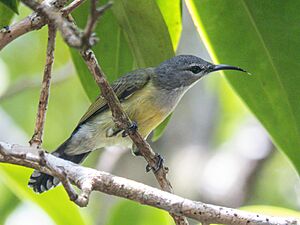Copper-throated sunbird facts for kids
Quick facts for kids Copper-throated sunbird |
|
|---|---|
 |
|
| male | |
 |
|
| female | |
| Conservation status | |
| Scientific classification | |
| Genus: |
Leptocoma
|
| Species: |
calcostetha
|
| Synonyms | |
|
Nectarinia calcostetha |
|
The copper-throated sunbird (Leptocoma calcostetha) is a small, colorful bird. It belongs to the sunbird family, called Nectariniidae. These birds eat mostly nectar from flowers and tiny insects.
Sunbirds are known for their special beaks that curve downwards. They also have bright yellow feathers on their chests, hidden under their wings. You can find copper-throated sunbirds in Southeast Asia, especially near the coast.
Contents
Discovering the Copper-Throated Sunbird
The copper-throated sunbird is part of the sunbird family, Nectariniidae. This family includes sunbirds and spiderhunters. These birds are famous for eating nectar, having curved beaks, and wearing bright, colorful feathers.
The copper-throated sunbird belongs to a small group called Leptocoma. There are only six types of birds in this group today. The name Leptocoma comes from old Greek words. Leptos means "delicate" or "refined," and komē means "hair."
The species name calcostetha also comes from Greek. Khalkos means "bronze," and stēthos means "breast." This name perfectly describes the male bird's shiny throat! Sunbirds live in Africa, Asia, and Australia. Scientists think they first appeared in Asia and then spread to other places.
What Does a Copper-Throated Sunbird Look Like?
Copper-throated sunbirds are small birds, usually about 12 to 13 centimeters long. Their wings can spread about 57.5 millimeters wide, and their tails are around 45.5 millimeters long.
Male Sunbirds
Adult male sunbirds are mostly black. But they have amazing shimmering green colors on their heads, shoulders, and upper backs. Their throats are a shiny copper color. Around this copper patch, there's a shimmering purplish-blue ring that goes down to their chest. They have black legs and black eyes with no rings around them. Their beaks are black and curve downwards. They also have bright yellow feathers on their chests, hidden under their wings. Many sunbirds share these features.
Female Sunbirds
Adult female sunbirds also have black legs and a curved black beak. But their eyes have a white ring that isn't complete. Their bellies are olive-yellow, and their backs are grayish-olive. Instead of a copper throat, females have a grayish-white throat that stands out against their gray heads.
Young Sunbirds
Young sunbirds look a lot like the females. However, their grayish-white throats are yellow, sometimes with dark scales.
Where Do Copper-Throated Sunbirds Live?
Copper-throated sunbirds live across Southeast Asia. You can find them in places like Singapore, Vietnam, Malaysia, the Philippines, Myanmar, Cambodia, and western Indonesia (like Java Island).
They mostly stay in areas near the coast all year round. They don't usually go far inland. These sunbirds live in both natural forest areas and places changed by people.
Habitats They Prefer
Their natural forest homes include tropical lowlands, mangrove forests, and other types of forests. In areas changed by people, they live in plantations, coconut groves, and gardens. You can often spot them in flowering bushes or trees. They usually stay in the middle or upper parts of the tree canopy.
How Do Copper-Throated Sunbirds Behave?
What Do Copper-Throated Sunbirds Eat?
Copper-throated sunbirds eat both nectar and small insects. They are very active birds, zipping from tree to tree to find food. They look for tiny insects and sweet nectar.
Unlike hummingbirds, which can hover perfectly, sunbirds can only hover for a short time to drink nectar. They can't do it continuously. One plant they love for nectar is Bruguiera. These plants grow in mangrove forests in Africa, Asia, and Australia. For insects, sunbirds pick them off twigs and leaves. This is called "gleaning."
How Do Sunbirds Help Plants? (Pollination)
Since these birds drink nectar, they are very important for pollinating plants. When a sunbird collects nectar, parts of its body touch the flower's anthers. Anthers are the male parts of the flower that release pollen. As the bird flies to different flowers, it carries pollen to the female parts of other flowers. This helps the plants make seeds.
Sometimes, sunbirds can accidentally damage flowers. If they damage the parts that help the flower make seeds, it can stop the plant from being fertilized.
Reproduction and Life Cycle
Copper-throated sunbirds start laying eggs as early as January and continue until July. They usually lay two eggs at a time. The eggs are grayish-brown with dark spots. Young birds, called nestlings, start to appear around July.
Both the male and female sunbirds work together to build the nest. They weave fine grass, fibers, and hairs into a pear-shaped nest. This makes the nest blend in with the tree bark and leaves, making it hard to spot. The nest has a strong base and an oval entrance with a small roof. Sometimes, the parents build extra "decoy" nests. They probably do this to confuse predators or other birds that might try to lay their eggs in the sunbird's nest, like cuckoos. Cuckoos are known to lay their eggs in other birds' nests in Eastern Asia and Africa.
What Do Copper-Throated Sunbirds Sound Like?
Their songs are like a beautiful, squeaky trill with changing notes. The song has short pauses and ends with a single sharp squeak. Their calls sound like a "squee-" that slowly gets lower in pitch. We don't have much information about how copper-throated sunbirds use their different sounds.
Are Copper-Throated Sunbirds Safe?
The International Union for Conservation of Nature (IUCN) looked at the copper-throated sunbird in October 2016. They decided it was a species of "least concern." This means they are not worried about this bird becoming endangered.
Even though we don't know the exact number of these birds, they are not considered rare. Because their numbers don't seem to be dropping and they live in a large area, it suggests their populations are stable.
Gallery





